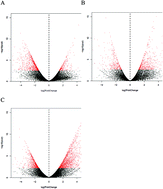High-throughput transcriptome sequencing reveals extremely high doses of ionizing radiation-response genes in Caenorhabditis elegans†
Abstract
This study sought novel ionizing radiation-response (IR-response) genes in Caenorhabditis elegans (C. elegans). C. elegans was divided into three groups and exposed to different high doses of IR: 0 gray (Gy), 200 Gy, and 400 Gy. Total RNA was extracted from each group and sequenced. When the transcriptomes were compared among these groups, many genes were shown to be differentially expressed, and these genes were significantly enriched in IR-related biological processes and pathways, including gene ontology (GO) terms related to cellular behaviours, cellular growth and purine metabolism and kyoto encyclopedia of genes and genomes (KEGG) pathways related to ATP binding, GTPase regulator activity, and RNA degradation. Quantitative reverse-transcription PCR (qRT-PCR) confirmed that these genes displayed differential expression across the treatments. Further gene network analysis showed a cluster of novel gene families, such as the guanylate cyclase (GCY), Sm-like protein (LSM), diacylglycerol kinase (DGK), skp1-related protein (SKR), and glutathione S-transferase (GST) gene families which were upregulated. Thus, these genes likely play important roles in IR response. Meanwhile, some important genes that are well known to be involved in key signalling pathways, such as phosphoinositide-specific phospholipase C-3 (PLC-3), phosphatidylinositol 3-kinase age-1 (AGE-1), Raf homolog serine/threonine-protein kinase (LIN-45) and protein cbp-1 (CBP-1), also showed differential expression during IR response, suggesting that IR response might perturb these key signalling pathways. Our study revealed a series of novel IR-response genes in Caenorhabditis elegans that might act as regulators of IR response and represent promising markers of IR exposure.



 Please wait while we load your content...
Please wait while we load your content...